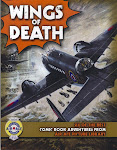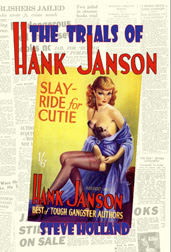
The Illustrative Art of Charles Pears
by Gordon Howsden
by Gordon Howsden
From joke cartoonist and theatrical caricaturist to distinguished war artist and President of the Royal Society of Marine Artists, Charles Pears certainly made best use of his significant artistic talents.
Born on 9 September 1873 in Pontefract, Yorkshire, Charles' early inspiration came from his father, George William Pears, who was a competent amateur painter. Educated at East Hardwick College, he started his working life as an assistant in his father's tailors shop. He found a useful source of extra pocket money by submitting some of his sketches to the local weekly paper, the Yorkshireman but his breakthrough came when he entered and won a competition organized by the leading fine art magazine, The Studio.
 Moving to London, Pears was soon contributing to several magazines, including Punch, the Dome, the Longbow and the Sketch, before securing the position of theatrical caricaturist for Pick-Me-Up magazine in 1898. A collection of his drawings taken from the latter was published in 1902 under the title, Men: Drawn and Rhymed About. In similar vein he edited and illustrated Mr. Punch's Book for Children and followed it up with Mr. Punch's New Book for Children in 1903.
Moving to London, Pears was soon contributing to several magazines, including Punch, the Dome, the Longbow and the Sketch, before securing the position of theatrical caricaturist for Pick-Me-Up magazine in 1898. A collection of his drawings taken from the latter was published in 1902 under the title, Men: Drawn and Rhymed About. In similar vein he edited and illustrated Mr. Punch's Book for Children and followed it up with Mr. Punch's New Book for Children in 1903.
 That same year he provided the illustrations for the book, Toby and his Little Dog Tan written by James Gilbert and for the next twenty years he was to receive regular commissions from book publishers. Apart from book and magazine illustrations Pears also carried out commercial work for clients, of which his postcard designs for chocolate makers J S Fry & Co are now highly prized by collectors.
That same year he provided the illustrations for the book, Toby and his Little Dog Tan written by James Gilbert and for the next twenty years he was to receive regular commissions from book publishers. Apart from book and magazine illustrations Pears also carried out commercial work for clients, of which his postcard designs for chocolate makers J S Fry & Co are now highly prized by collectors.During the Edwardian years Pears began to make a name for himself within the fine art world and exhibited at several galleries. Nine of his works were accepted by the Royal Academy and other prominent institutions that exhibited his paintings were the Royal Institute of Oil Painters, where he was elected a member in 1913, the Fine Art Society, the New English Art Club and the Royal Institute of Painters in Watercolour.
Sailing and the sea were to become lifetime passions and in 1910 Charles Pears wrote his first book on the subject titled From the Thames to the Seine and he followed this up in 1914 with From the Thames to the Netherlands. Although the 1914/18 war interrupted his burgeoning career, Pears' maritime skills were put to good use as an official Admiralty War Artist. Several of his paintings from this period are held by the Imperial War Museum. He still found time for commercial work including some dramatic action pictures for The Illustrated London News.

 After the war he became one of a long line of distinguished artists to illustrate a volume of Alice in Wonderland but book and magazine illustrations gradually gave way to his marine paintings and poster designs. This latter work had started in 1913 with some designs for the London Underground, which continued through to 1936. He also created some magnificent posters for the railway companies and the Empire Marketing Board. A particular favourite of mine from 1938 is titled "The Cambrian Coast" which was commissioned by the GWR and, along with other examples of his work, this is illustrated in Railway Posters 1923-1947 by Beverley Cole and Richard Durack.
After the war he became one of a long line of distinguished artists to illustrate a volume of Alice in Wonderland but book and magazine illustrations gradually gave way to his marine paintings and poster designs. This latter work had started in 1913 with some designs for the London Underground, which continued through to 1936. He also created some magnificent posters for the railway companies and the Empire Marketing Board. A particular favourite of mine from 1938 is titled "The Cambrian Coast" which was commissioned by the GWR and, along with other examples of his work, this is illustrated in Railway Posters 1923-1947 by Beverley Cole and Richard Durack.
 In 1938 he was asked by John Player & Sons to produce a series of 25 paintings for a set of cigarette cards titled "Racing Yachts". He later admitted that of all vessels yachts were among his least favourite marine subjects, due to the fastidiousness of their owners who liked everything to be precisely depicted. However, he did John Player proud with some excellent paintings of many craft that were active at the time. In all probability he also wrote the informative texts on the reverse of the cards. He had by this date written and illustrated a total of five books on sailing although, sadly, the only volume with colour illustrations is Yachting on the Sunshine Coast published by the Southern Railway Company in 1932.
In 1938 he was asked by John Player & Sons to produce a series of 25 paintings for a set of cigarette cards titled "Racing Yachts". He later admitted that of all vessels yachts were among his least favourite marine subjects, due to the fastidiousness of their owners who liked everything to be precisely depicted. However, he did John Player proud with some excellent paintings of many craft that were active at the time. In all probability he also wrote the informative texts on the reverse of the cards. He had by this date written and illustrated a total of five books on sailing although, sadly, the only volume with colour illustrations is Yachting on the Sunshine Coast published by the Southern Railway Company in 1932.During World War II, Pears again acted as an Official War Artist and the resultant works are now shared between the Imperial War Museum and the National Maritime Museum at Greenwich. Several images of his paintings can be viewed by accessing the IWM and NMM websites. Just prior to the war he had founded the Royal Society of Marine Artists of which he became the first President. An award in his name is still given by the Society to this day.
Between September 1949 and January 1950, Charles Pears contributed a series of five articles to Artist magazine titled “On Marine Painting” These are most informative and apart from the valuable advice given to budding marine artists they also provide an insight into the method Pears used to create his atmospheric paintings. Among several illustrations that accompanied these articles are photographs of Pears in his studio and also a very fine picture of his own yacht "Wanderer".
Having moved from London to St Mawes in Cornwall to be near the sea that he loved, Charles Pears died on 28 January 1958. The bibliography below is taken from the British Library Catalogue, AbeBooks and my own collection. I must also give credit to Tony Woolrich, whose listing of the artists who contributed to Modern Wonder magazine included the name of Charles Pears, and reminded me that this artist's varied work might be of interest to other Bear Alley devotees.
PUBLICATIONS

 Books by Charles Pears
Books by Charles PearsMen: Drawn and Rhymed About. London, Black & White Publishing Co, 1902.
Mr. Punch's Book for Children. London, Punch Office, 1902.
Mr. Punch's New Book for Children. London, Punch Office, 1903.
From the Thames to the Seine. London, Chatto & Windus, 1910.
From the Thames to the Netherlands. London, Chatto & Windus, 1914.
South Coast Cruising. London, Edward Arnold, 1931.
Yachting on the Sunshine Coast. London, Southern Railway Company, 1932.
Going Foreign. London, Edward Arnold, 1933.
Books Illustrated by Charles Pears
Toby and his Little Dog Tan by James Gilbert. London, Hodder & Stoughton, 1903.
Glyn Severn's Schooldays by George M Fenn. London & Edinburgh, W & R Chambers, 1904.
The Pedlar's Pack by Mrs Alfred Baldwin. London & Edinburgh, W & R Chambers, 1904.
A Christmas Carol by Charles Dickens. London, Library Press, 1905.
From Fancy's Realm by Louisa Baldwin. London & Edinburgh, W & R Chambers, 1905.
Christmas Eve by Robert Browning. London & Edinburgh, T.C. & E.C. Jack, 1906.
Poems of Coleridge Ed. by Edward Dowden. Edinburgh, T.C. & E.C. Jack, 1906.
Lady Geraldine's Courtship by Elizabeth Barrett Browning. London & Edinburgh, W & R Chambers, 1906.
Poems of Whittier Ed. by Arthur C Benson. London, Caxton Publishing, 1906.
The Heroes or Greek Fairy Tales for my Children by Charles Kingsley. London, Gowans & Gray, 1907.
Some Round About Papers by W.M. Thackeray. Edinburgh & London, T.N. Foulis, 1908.
By Their Fruits by Rosa Caroline Praed. London, Cassell, 1908.
Mr. Midshipman Easy by Captain Marryat. London, Collins, 1908.
The Middy of the "Blunderbore" by Charles Gleig. London & Edinburgh, W & R Chambers, 1909.
Old Christmas by Washington Irving. London, Chatto & Windus, 1909.
Robert Orange by John Oliver Hobbes. London, Collins, 1910.
The Four Georges and the English Humorists by W.M. Thackeray. London, Collins, 1910.
On Windycross Moor by Mabel Quiller Couch. London & Glasgow, Collins, 1910.
Sea Yarns by John Arthur Barry. London & Edinburgh, W & R Chambers, 1910.
With Morgan to Panama by Edward Hamilton Currey. London & Edinburgh, W & R Chambers, 1911.
Two Years Before the Mast by Richard Henry Dana. London, Macmillan, 1911.
The Waverley Edition of the Works of Charles Dickens. London, Waverley, 30 vols., 1913-1915.
In the Press and Out Again by Robert P Gossop. London, St Catherine Press, 1913.
A Born School Captain by W J Batchelder. London, Blackie, 1915.
Salt-Water Poems & Ballads by John Masefield. New York, Macmillan, 1916.
Sea Scouts All by Percy Westerman. London, Blackie, 1920.
Sea Scouts Abroad by Percy Westerman. London, Blackie, 1921.
The East Africa Force 1915-1919 by Brigadier-General C.P. Fendall. London, H.F. & G. Witherby, 1921.
Alice in Wonderland by Lewis Carroll. London, Collins, 1922.
Cissy by E Maria Albanesi. London, Collins, 1920s?.
Endless Story: An Account of the Work of the Destroyers, Flotilla Leaders, Torpedo Boats and Patrol Boats in the Great War by 'Taffrail' (Taprell Dorling). London, Hodder & Stoughton, 1931.
The Diary of Benjamin Newton Ed. by C.P. Fendall & E.A. Crutchley. Cambridge, University Press, 1933.
Books, Annuals etc Containing Illustrations by Charles Pears
Pears Annual, 1914.
The Children's Treasure Book. London, Odhams, 1934.
Soho Centenary: A Gift from Writers, Artists and Musicians. London, Hutchinson, 1944.




















































.jpg)




.JPG)














































